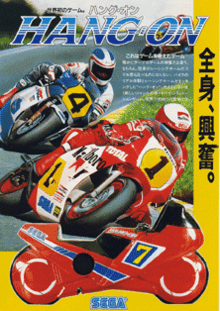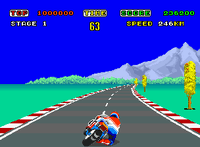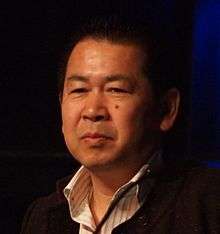Hang-On
Hang-On[lower-alpha 1] is an arcade game released by Sega in 1985 and later ported to the Master System. In the game, the player controls a motorcycle against time and other computer-controlled bikes. It was one of the first arcade games to use 16-bit graphics and utilizes the Super Scaler arcade system board, created with design input from Suzuki, as technology to simulate 3D effects. The deluxe cabinet version also introduced a motion controlled arcade cabinet, where the player's body movement on a large motorbike-shaped cabinet corresponds with the player character's movements on screen.
| Hang-On | |
|---|---|
 Original arcade flyer with the deluxe arcade cabinet pictured at the bottom | |
| Developer(s) | Sega |
| Publisher(s) | Sega |
| Designer(s) | Yu Suzuki |
| Composer(s) | Hiroshi Kawaguchi |
| Platform(s) | Arcade, SG-1000, Master System, MSX, PC-88[1] |
| Release | |
| Genre(s) | Racing |
| Mode(s) | Single-player |
| Cabinet | Upright, deluxe |
| Arcade system | Super Scaler (Sega Hang-On hardware) |
Yu Suzuki began development of Hang-On after deciding to design a motorcycle racing game as a way to use a torsion bar in an arcade game. With market research suggesting GP 500 racing was popular, Suzuki took inspiration from world champion Freddie Spencer and his style of racing. The game's soundtrack was written by Hiroshi Kawaguchi, who used rock music that was uncommon in arcade games at the time.
Hang-On was very popular at launch and sold well for Sega. Several sequels were later made for arcade, as well as video game consoles. It received positive critical reception for its realism and graphics, despite some initial modesty concerns in Japan, and has been recognized as a well-remembered and influential arcade game.
Gameplay

Using a behind the motorcycle perspective, the player races a linear race track divided into several stages within a limited time. Players have to lean the motorcycle in order to turn, with tighter corners requiring a further lean.[3] A throttle similar to a motorcycle has to be twisted to accelerate the bike.[4] The game has one track, pieced together in segments.[5] Reaching a checkpoint at the end of each segment extends the time limit, and remaining time is carried over into the next stage.[6] Running off the track results in the motorcycle crashing and the rider is launched into the air.[7] The game ends if the time runs out or all five stages are completed.[6]
Development

Hang-On was the second game to be developed by Yu Suzuki, the first being 1984's Champion Boxing.[8] Development of Hang-On began with a project brought to him by a colleague who asked him to implement a torsion bar into an arcade game design—although the bar proved too difficult to implement in the final game design and springs were used instead. Suzuki was given the freedom to decide what kind of game to design, and as a fan of cars and motorcycles, he chose to design a game where the arcade cabinet simulated an actual motorcycle and players would have to move side to side on the motorcycle in order to turn.[5][9] He also had a desire to make his game better than Pole Position, a Namco game which had beaten out Sega's Turbo in popularity.[10] In developing the game, Suzuki wanted to make his new motorcycle racing game a realistic experience. His initial desire was to create a 3D game,[11] though the technology of the time made full 3D environments impossible. Instead, he specified the design of Sega's new Super Scaler arcade system board—initially known as Sega Hang-On hardware[5]—enhanced from the existing VCO Object system board that would utilize multiple CPUs and back end DSP compatibility to create 3D effects,[9][11] while utilizing 16-bit graphics.[12] The game achieves its 3D effects using a sprite-scaling technique.[13]
In designing the game, Suzuki had to decide on a style of motorcycle racing for the game. Suzuki himself was a fan of dirt bikes, along with motocross and Enduro,[5] and dirt bikes would later be used in Suzuki's Enduro Racer.[14] However, Sega's market research concluded that road-based GP 500 racing was more popular worldwide. While Suzuki was doing research for the game, he admired the riding style of Freddie Spencer, who had just become the youngest person to win a motorcycling world championship at 21 years old. According to Suzuki, "Freddie Spencer's riding style, it was so nice. And my game was like a homage. That's the reason I wanted to make it - Freddie Spencer, he rode a Honda bike, and I loved the way he hung on!"[11] Two cabinet designs were made: a basic version with a handlebar and levers, and the deluxe cabinet which featured the full motorcycle to be tilted. Suzuki had additional features he wanted to implement that could not be done due to cost, including a gyroscope to simulate motorcycle acceleration and deceleration.[11] The title is derived from when the biker is turning and has to "hang on" to the bike while the bike is leaning, which Suzuki had read in a Japanese bike magazine. Suzuki later learned the technique was called "hang off" in North America, but he chose to keep the former name.[15]
Hang-On is considered well-regarded for its music, which was composed by Hiroshi Kawaguchi.[5] He came to Suzuki's attention after Suzuki heard he played in a band. Suzuki wanted songs for the soundtrack to Hang-On that would be like what a band would play. This led to Kawaguchi writing four songs for the game, including "Theme of Love", the game's theme song. Kawaguchi made use of the hardware's PCM sampling and added drum samples to use Hang-On's Yamaha YM2203 sound chip to its maximum potential and create a more realistic soundtrack featuring rock music, which was uncommon in arcade games at the time. He also created the game's sound effects.[16] Kawaguchi did not program his own music into the game; he instead wrote out his soundtrack by hand, made a demo, and gave that to the sound programmer. He has said this was because he did not own a sequencer, and that this method was faster for him.[17]
Release

At its debut in Japan, Hang-On's deluxe cabinet was criticized as being inappropriate for Japanese culture. Suzuki recalled in an interview about criticisms about how the shyness of the Japanese people would mean no one would want to straddle a motorcycle in front of others, or how the motorcycle would be especially unsuitable for players wearing miniskirts. These criticisms would eventually subside when players lined up to play the game.[5]
In North America, the game was introduced to the public by the company's American arcade subsidiary, Sega Enterprises USA, headed by Tom Petit. Previously, Sega Enterprises USA had focused on selling refurbished arcade cabinets, and before the release of Hang-On, Petit was concerned that his division would be shut down due to competition when he was summoned to Japan to meet with Sega president Hayao Nakayama in 1985. Instead, he was brought to be shown the Hang-On deluxe cabinet. Sega Enterprises USA introduced Hang-On to Sega's American and Canadian distributors at the Red Lion Inn in San Jose, California in October 1985. Orders were placed immediately for several hundred units. The success of Hang-On's arcade cabinets, both upright and deluxe, were so great that the company struggled to keep up with demand.[5]
Reception and legacy
| Reception | ||||||||||||||||
|---|---|---|---|---|---|---|---|---|---|---|---|---|---|---|---|---|
| ||||||||||||||||
In Japan, Game Machine listed Hang-On on their August 1, 1985 issue as being the most-successful upright arcade unit of the year.[22] The game received positive reviews. Computer and Video Games gave the arcade version a rave review. The reviewer called it the most realistic arcade game to be released, citing the need to tilt the bike and the placement of the throttle and brake controls being where they are on a real motorcycle. Also cited were the quality of the graphics, being compared to Pole Position.[3] The same magazine later reviewed the Master System port and scored it positively.[6] Sinclair User commended Hang-On for its simple-yet-fun gameplay, responsive controls, and unique tilt-based arcade cabinet.[23] ACE praised the quality of the Master System conversion, though noted there were some minor graphics jerks compared to the original as well as the loss of the crashing graphics of the arcade version.[7] British magazine Sega Pro called the Master System port "a damn fine racing game".[24]
An SG-1000 exclusive sequel, Hang-On II, was released in 1985, though it was essentially a port of the original game modified to work within the limitations of the console hardware.[25] Another arcade sequel, Hang-On Jr., was published in 1986 for Sega's System E arcade system board.[5] Hang-On itself was ported to the Master System as the system's pack-in game along with Astro Warrior or Safari Hunt depending on the package purchased.[12] In 1987, it was followed by a sequel, Super Hang-On, for arcade and a range of platforms.[26][27] A polygon-based sequel developed by Genki was released for the Sega Saturn, named Hang-On GP.[28]
In a 1995 interview, Suzuki said he felt Hang-On was his most impressive game at the time of release.[29] Retro Gamer cited Hang-On as the first example of a full-body experience game because of the deluxe cabinet's ride-on controls, and noted the game as being popular, though less impressive than Out Run.[4] Former Sega arcade director Akira Nagai has credited Hang-On as one of the titles that helped to bring arcade games out of the 1982 downturn and created new genres of arcade games.[30] According to video game journalist Ken Horowitz, Hang-On is remembered more for its gameplay than its sales, in part because it was unique in arcades at the time, and that it was an example that "when it came to arcade innovation, Sega was at the top of the industry."[5]
See also
Notes
- ハングオン Hangu On
References
- Ali, Zuhaad (December 7, 2019). "Best Arcade Racing Games Of All Time, Ranked". TheGamer. Retrieved February 14, 2020.
- Akagi, Masumi (13 October 2006). セガ社 (Sega); Sega; H. アーケードTVゲームリスト 国内•海外編 (1971-2005) (in Japanese) (1st ed.). Amusement News Agency. pp. 36, 131, 154. ISBN 978-4990251215.
- "Arcade Action". Computer and Video Games. No. 50. December 1985. p. 89.
- "The Bluffer's Guide to Arcade Racers". Retro Gamer. No. 124. Imagine Publishing. January 2014. p. 21.
- Horowitz, Ken (2018). The Sega Arcade Revolution: A History in 62 Games. McFarland & Company. pp. 92–97. ISBN 9781476631967.
- "Mean Machines Reviews". Computer and Video Games. No. 77. March 1988. p. 121.
- "Which Console?". ACE. No. 1. October 1987. p. 20.
- "『セガ3D復刻アーカイブス3 FINAL STAGE』を鈴木裕氏と中裕司氏の2大クリエイターが熱く語る【新春特別企画】". Famitsu (in Japanese). January 20, 2017. Archived from the original on May 28, 2019. Retrieved February 6, 2020.
- "The Arcade Pioneer: The Story of Yu Suzuki". Retro Gamer. No. 150. Future plc. January 2016. pp. 96–99.
- Davies, Jonti (September 2008). "The Making Of: OutRun". Retro Gamer. No. 54. Imagine Publishing. pp. 26–33. ISSN 1742-3155.
- Robinson, Martin (March 22, 2015). "Out Ran: Meeting Yu Suzuki, Sega's original outsider". Eurogamer. Gamer Network. Archived from the original on December 20, 2015. Retrieved December 24, 2015.
- Fahs, Travis (April 21, 2009). "IGN Presents the History of SEGA". IGN. Archived from the original on March 30, 2012. Retrieved February 6, 2020.
- Grazza, Brian (October 5, 2017). "OutRun". Hardcore Gaming 101. Kurt Kalata. Archived from the original on October 14, 2017.
- Kalata, Kurt. "Hardcore Gaming 101: Enduro Racer". Hardcore Gaming 101. Archived from the original on June 17, 2015. Retrieved June 3, 2015.
- "Episode 10". GameCenter CX. 2003. Fuji TV.
- Horowitz, Ken (February 15, 2016). "Sega Stars: Hiroshi Kawaguchi". Sega-16. Archived from the original on August 1, 2019. Retrieved February 6, 2020.
- "The Rock Stars of Sega – 2009 Composer Interview". game music core (in Japanese). 2009. Archived from the original on October 8, 2016. Retrieved February 6, 2020 – via Shmuplations.
- "Hang-On". AllGame. Archived from the original on November 14, 2014. Retrieved February 6, 2020.
- "Hang-On". Génération 4 (in French). No. 1. November 1987. p. 30.
- "A fond les manettes". Tilt (in French). No. 49. December 1987. pp. 98–99.
- "Sistema Sega Master System". VideoGame (in Portuguese). Vol. 1 no. 2. 1991. p. 44.
- "Game Machine's Best Hit Games 25 - アップライト, コックピット型TVゲーム機 (Upright/Cockpit Videos)". Game Machine (in Japanese). No. 265. Amusement Press, Inc. 1 August 1985. p. 25.
- "The Arcade Coin". EMAP. Sinclair User. February 1987. pp. 91–96. Archived from the original on 15 February 2020. Retrieved 22 February 2020.
- "Pro Review". Sega Pro. December 1991. p. 47.
- Marley, Scott (December 2016). "Essential Games: The Titles that Made the SG-1000 Shine". Retro Gamer. No. 163. Future Publishing. p. 58.
- "Super Hang-On". MegaTech. No. 6. EMAP. June 1992. p. 80.
- "Super Hang-On". Mega. No. 9. Future plc. June 1993. p. 23.
- "Finals". Next Generation. No. 14. Imagine Media. February 1996. p. 158.
- "Nothing Compares to Yu". Next Generation. Imagine Media (11): 7. November 1995.
- Sega Arcade History (in Japanese). Tokyo: Enterbrain. 2002. ISBN 9784757707900. Archived from the original on September 11, 2018. Retrieved September 11, 2018 – via Shmuplations.